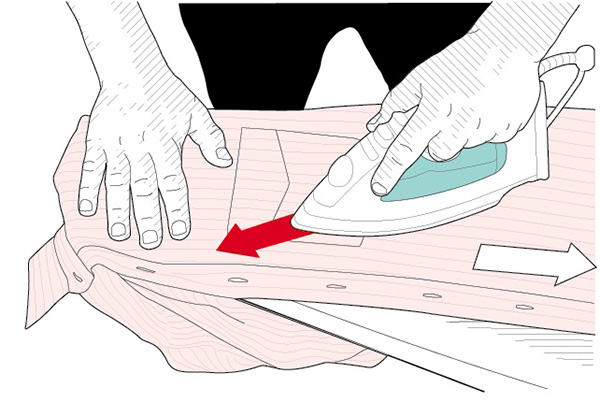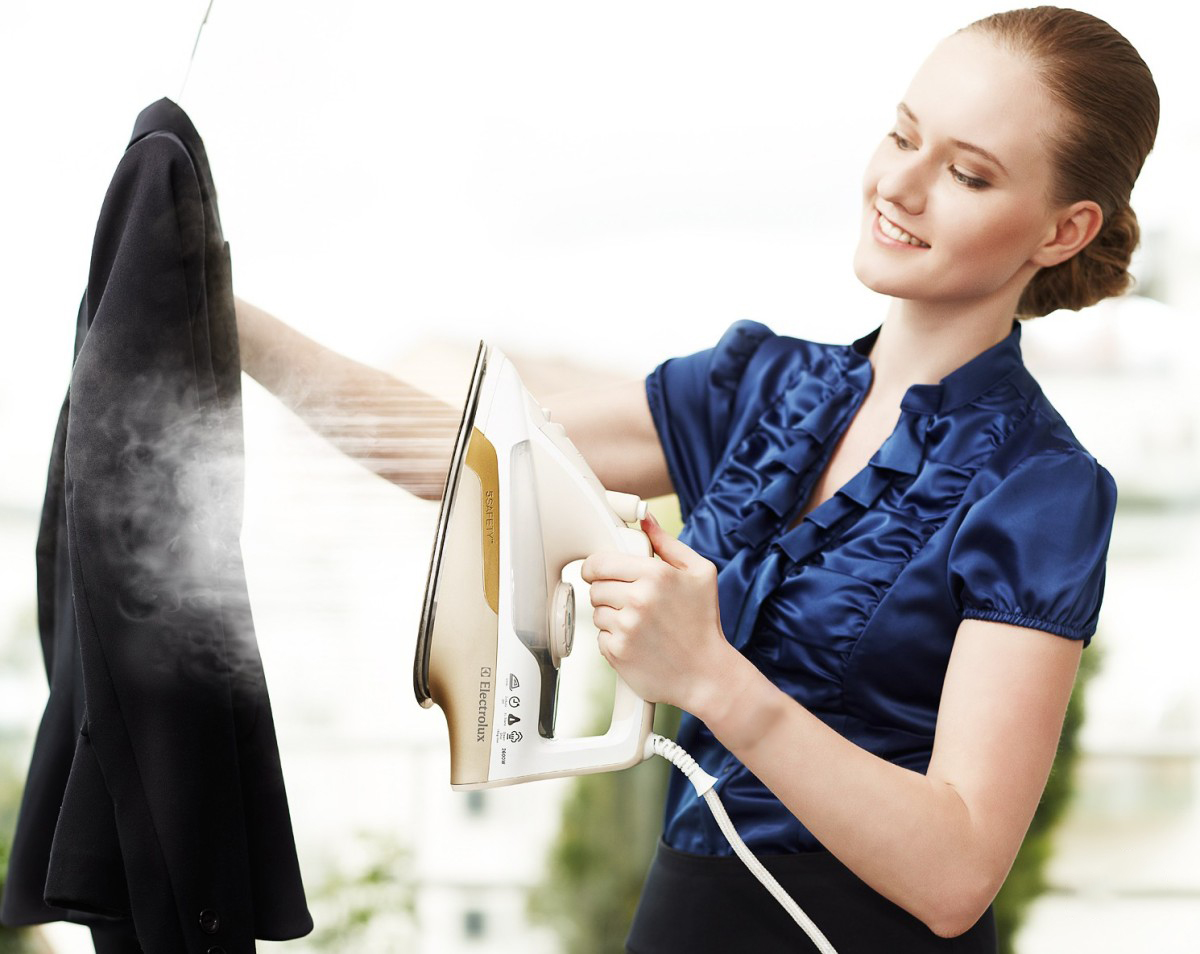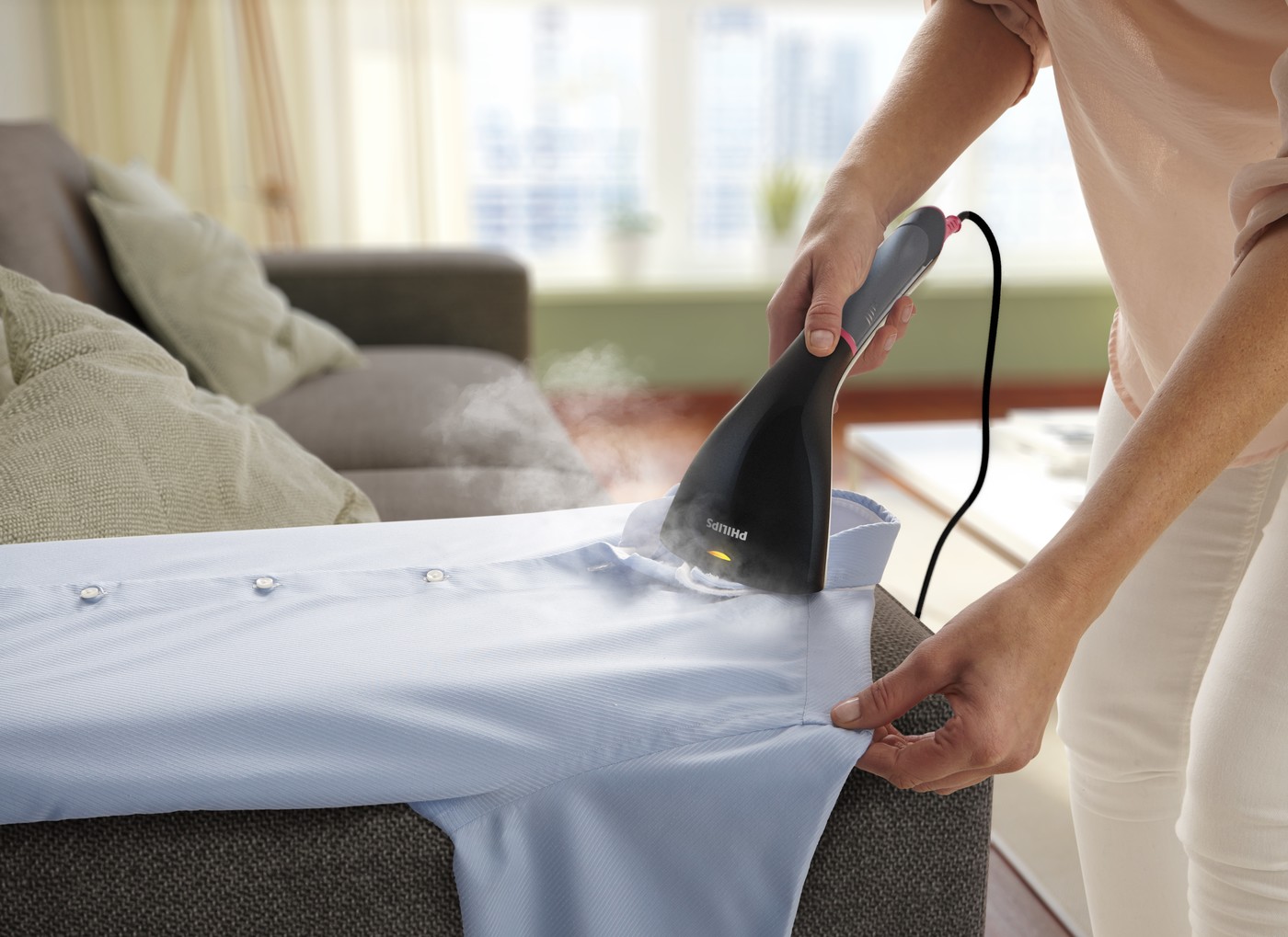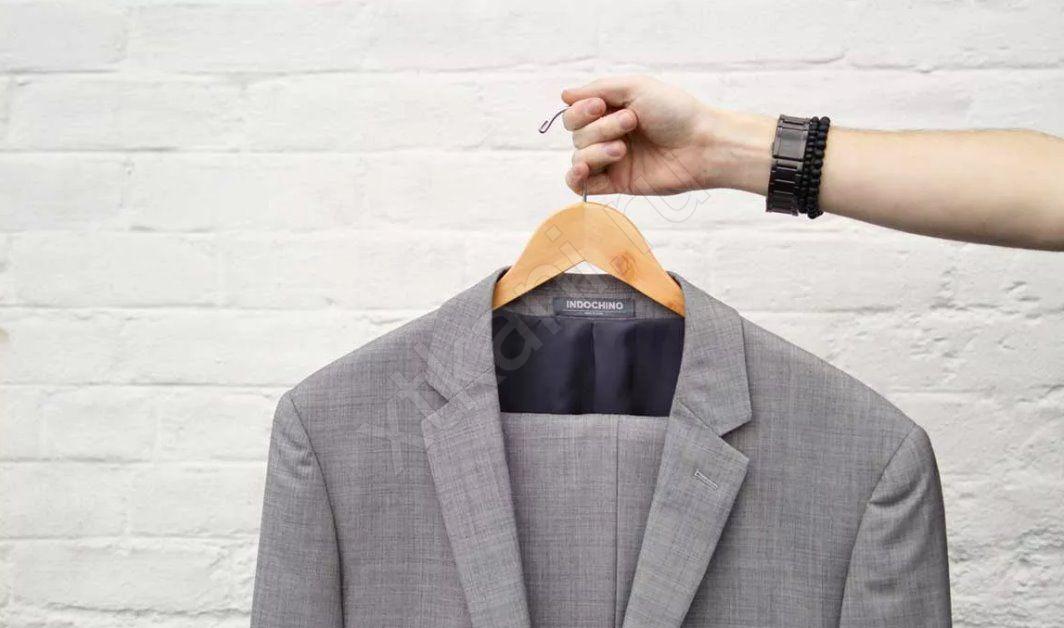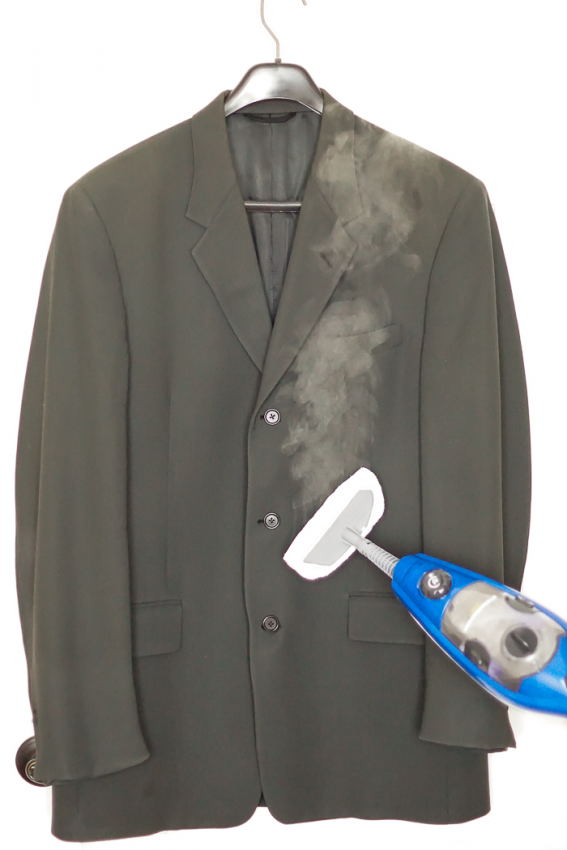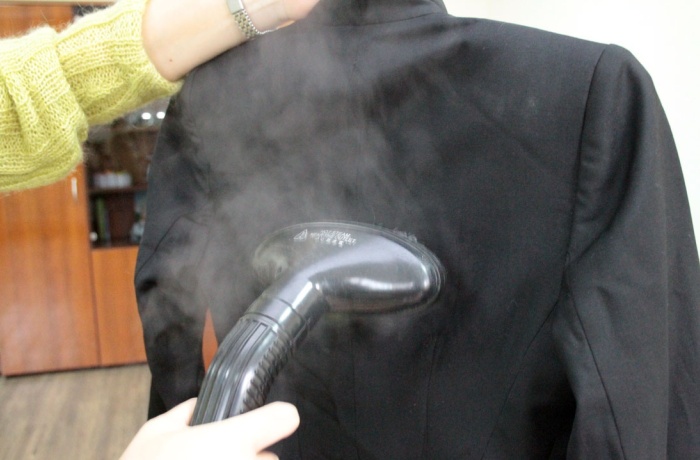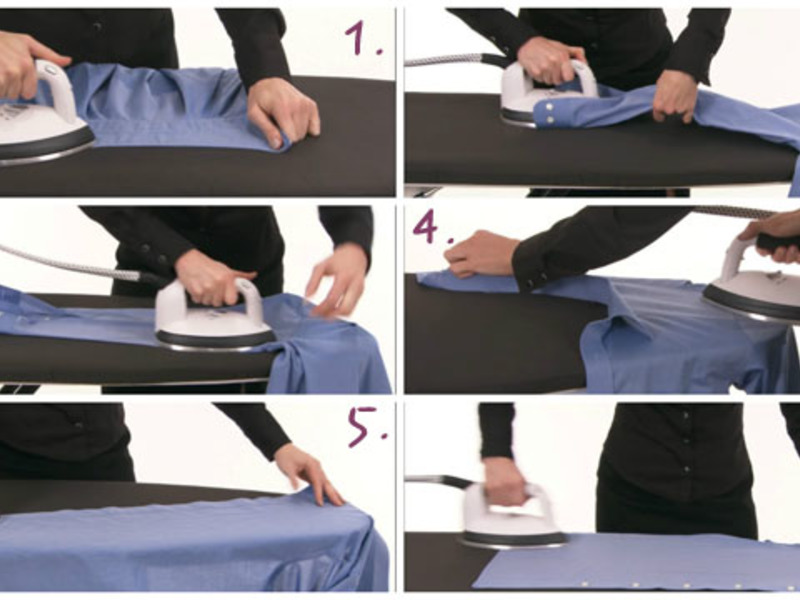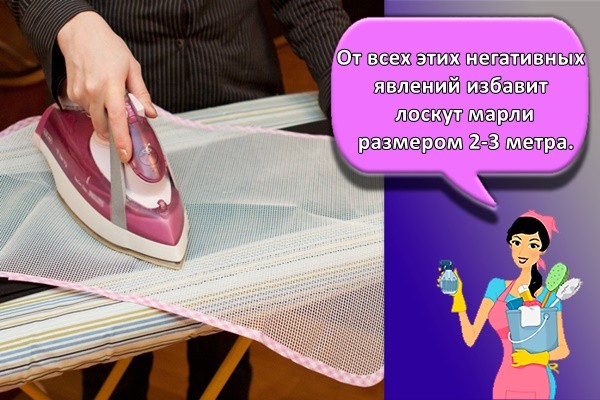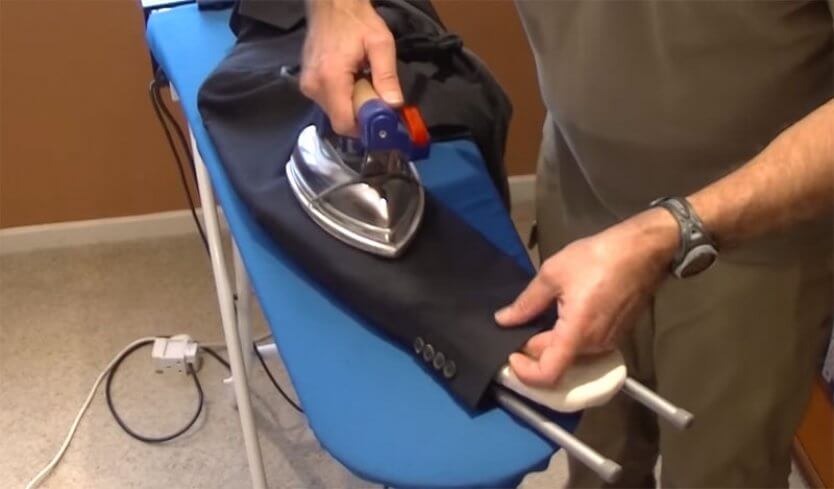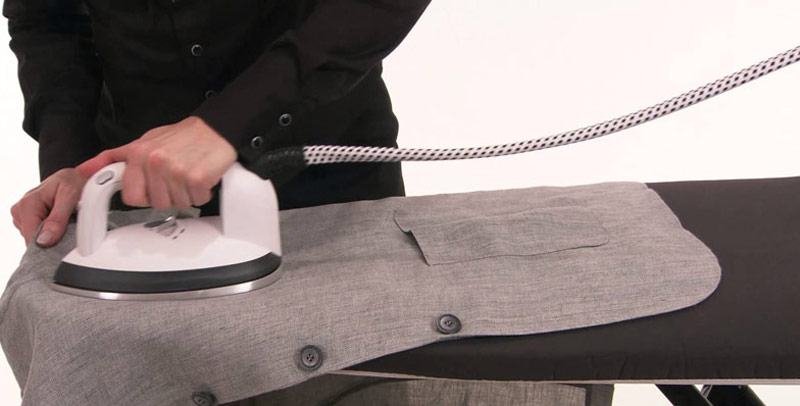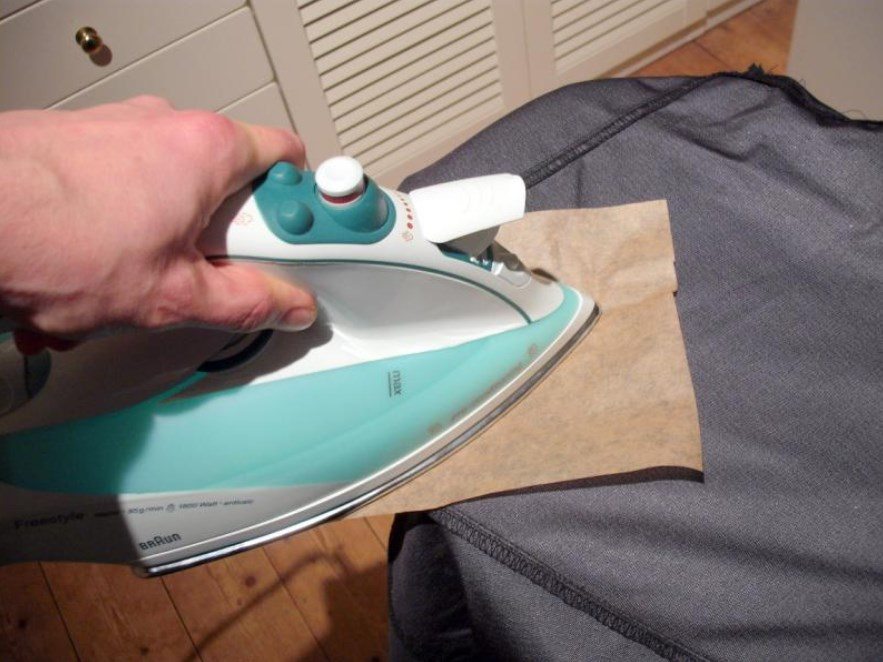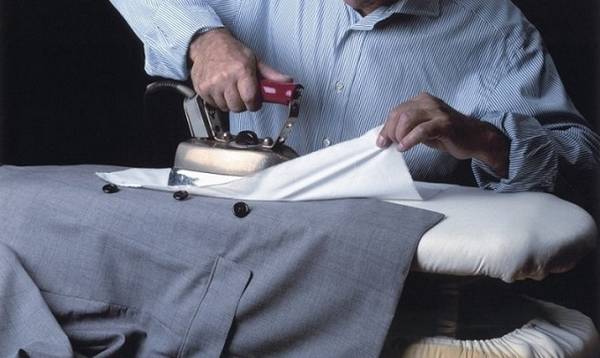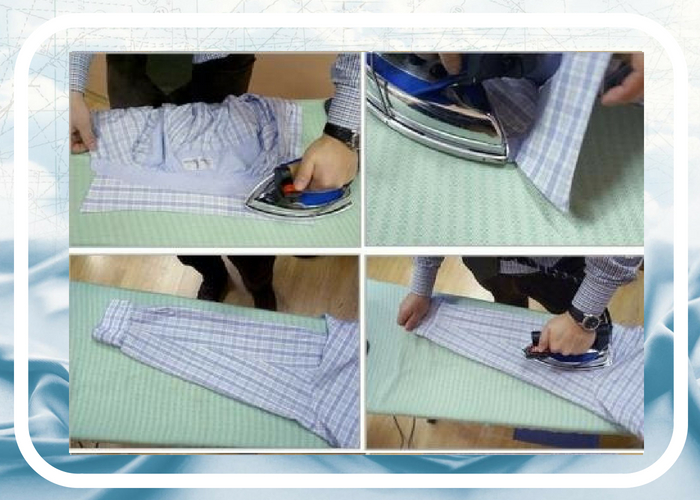Ironing procedure
The procedure for ironing a jacket is the same in all cases. It does not depend on the material or style of the product.
What to prepare for work
In addition to the iron itself, we need:
- ironing board or table with a bedspread;
- ironing sleeve or attachment for small parts;
- gauze or thin cloth;
- spray bottle with water.
Photo gallery: equipment necessary for ironing
Before starting work, brush the item and check for stains. Any stain after heat treatment can weld to the fabric, it will be very difficult to remove it.
Sequencing
- Unscrew the pockets, iron through a damp cloth and refill. First, carefully smooth the fabric with your hands so that there are no creases.
- We moisten the sleeves from a spray bottle, pull them onto a special attachment to the ironing board in the form of a narrow board, or a special curved device for sleeves. If you don't have one, it's better to get it. This will greatly help in the care of your clothes. As a last resort, you can use a rolled towel. Pull the seams slightly when ironing. Iron until fabric is dry.
- Use a pad to iron your shoulders. Reposition the iron as if steaming. Iron the sleeves and shoulders from the wrong side.
- We iron the bottom, shelves and back. Place them on the board so that the working area is as flat as possible, without wrinkles and creases. Spread out the lining. Iron from the right side through a flat iron.
- The lapels and collar are ironed first from the inside, then from the face. Carefully straighten the parts, cover with a damp cloth, apply an iron and hold until the fabric is completely dry. After ironing on both sides, bend the lapel and iron through the fabric, barely touching.
- Leave the ironed jacket on the ironing board to cool and dry completely. If you put it on right away, the thing will quickly be remembered.
Video: how to iron a jacket well and quickly
Steaming
If your iron has a vertical steaming function, it can be used to tidy things up. To do this, pour clean water into the iron reservoir and set the steam mode. We hang the product on a hanger.
By pressing the corresponding button, we direct the stream of steam onto the vertically hanging jacket, without touching the fabric with the sole of the iron. We carefully process creases and wrinkles, straightening them with your free hand
Be careful not to burn your skin with hot steam
However, it is more convenient to carry out such processing with a special steamer. In most cases, steam and water work just as well as an iron.
Video: smoothing a jacket with a steamer
Another way to remove wrinkles and creases from your jacket is with a homemade smoothing solution.
How to smooth out bruises with a special solution
- Take one part at a time of water, vinegar and fabric softener and mix.
- Moisten the thing with the mixture using a spray bottle, after hanging it on a hanger.
- Leave to dry completely, during this time the bruises will disappear.
For most classic jackets, the manufacturer does not provide the option of ironing at home. But if you still need to iron your jacket, do not be discouraged. Now you know how to do it right.
Product preparation and temperature selection
Before ironing a jacket from a women's or men's suit, you should make sure that this type of processing is not contraindicated for the product.
To do this, you need to pay attention to the label of the thing, where the necessary information is indicated.
In cases where a crossed-out iron is drawn on the tag, it is not recommended to subject the jacket to classic ironing.However, this icon does not prohibit other cooking methods, such as removing wrinkles and creases with a steamer.
Correct ironing of the product involves a preparatory stage. To do this, you will need to do the following.
- Empty the pockets of the product from the contents.
- Examine the surface for dirt and stains and, if present, wash clothing.
- In cases where the jacket is clean, it is worth walking over the surface with a clothing brush to remove lint, animal hair and dust.
- If there are deep folds on the thing, you will need to hang it over a basin of hot water and leave it for 10-15 minutes. This will help smooth out any creases.
- Select a suitable ironing temperature.
The last point causes some difficulties for inexperienced housewives. Information on the recommended heating of the iron can be obtained by carefully examining the label. There are dot icons here that indicate the degree of heating.
- One point. The recommended ironing temperature is from 90 to 115 degrees.
- Two points. You can iron the product well by setting the temperature to 120-140 degrees.
- Three dots. It is possible to rid the fabric of folds only when the iron is heated from 160 to 200 degrees.

Regardless of the quality of the product and the type of material from which the jacket is sewn, the following rules should be followed during ironing.
- Tidy up the element of the suit only on the ironing board, in extreme cases - spread it on a hard surface.
- Always use a damp gauze to prevent shiny flecks from forming on the fabric.
- Use the steaming function, if provided for the specific unit.
- To shape the product in the shoulder area, as well as to iron the sleeves, use a special roller or tightly rolled towel.
- Iron the shelf and back of the jacket not only from the front, but also from the seamy side.
- If the lapels and collar of the garment are badly wrinkled, these parts of the product will need to be well sprinkled with water, and stretch the fabric during ironing.
- If there is a pattern on the product, iron these areas from the wrong side, and if heat treatment is required "from the face", use a multi-layer lining made of thick paper or thick fabric.
- If greasy areas appear, iron them through a piece of woolen material.
- If the jacket is made of fluffy fabric, you can move the iron over the product only in the direction of the fluff.
- When there are fasteners in the form of metal or plastic buttons on the product, you should avoid heating the fittings, since under the influence of high temperatures they can melt or tarnish.
- Iron the parts of the product only in a certain order - this will help to avoid wrinkling of the already ironed parts of the garment.
To prevent the jacket from wrinkling immediately after ironing, it should be left on a hanger for a while. Only after the fabric has cooled and dried can it be put on or stored in a closet.

Ironing instructions at home
To iron a jacket at home, you must first prepare your workplace:
- Set up the ironing board so that the light falls on the left (left-handed on the right). This will make the creased spots on the product more visible.
- Prepare cheesecloth and filtered water. The gauze must be clean. Unfiltered water can leave yellow stains on the garment.
- The desired mode is set on the iron. It must comply with the manufacturer's recommendations for clothing.
- To iron a jacket correctly, you need to follow a specific procedure.
Back
The back of the jacket is a flat surface. Ironing it usually does not cause problems. Gauze is applied to the back, soaked in water and wrung out. It will be correct to pass on the gauze with an iron from top to bottom. This is done because the fabric is always pile down when sewing. Even if this pile is invisible to the naked eye, it can be.When the iron is drawn in the other direction, stripes are obtained that differ in tone from the main fabric.

Sleeves
It is more difficult to iron the sleeves of a jacket. To iron them out, use a small platform. The procedure is as follows:
- Pull the sleeve onto the platform.
- Cover it with damp gauze.
- Iron from top to bottom. The seams should be ironed with particular care. The shoulder and elbow seams should be perfectly straight.
- During the ironing process, the sleeve turns in a circle. The sewn-on buttons do not interfere with the action. A gauze layer will protect them from the effects of temperature.
Hangers
The hanger is one of the most difficult parts of ironing a jacket. The most correct solution would be to put them in order on a hanger using a steamer. But not everyone has this device. To iron the jacket correctly with an iron, you need:
- Hang your jacket on a hanger. Carefully level the shoulders with your hands.
- Set the iron to steam attack mode. Treat with hot steam from a distance of 20 cm, smoothing the shoulders with your hands during processing.
- Dry the jacket without removing it from the hanger.
Modern models allow the absence of classic details. If the jacket does not have foam inserts in the shoulder, then the shoulder seams can be smoothed out on a flat surface. To do this, just stretch them out on a small ironing board or rolled towel.

Straighten collar and lapels
It is impossible to iron a jacket correctly without straightening the collar and lapels. In order to bring these details into proper form, you should:
- Place the jacket on the ironing board and pull.
- Spread the lapels with your hands and apply damp gauze on them.
- Pass the iron from top to bottom. Iron hard-to-reach areas with the tip of the iron using a steam attack.
- To steam the collar, the jacket is pulled back over the ironing board. Level the collar and steam it. As the work progresses, the product rotates on the board, and the gauze and iron move to the shelves.
If the fabric is dense, then small parts are brought to perfect condition by pressing a hot iron against them and holding it for half a minute. You can do the same with lapels.
How to iron a jacket with an iron
To iron a jacket well, you need certain tools and devices, which, of course, can be easily found in every home. These include:
1. Ironing board with a narrow nozzle designed to thoroughly iron sleeves and other small parts. If there is no attachment, then it can be successfully replaced by a towel that rolls tightly into a roller.
2. Iron. Almost all modern models have a steaming function (steam comes out of special holes on the sole).
3. Gauze or other cotton fabric. 
How to prepare a jacket for ironing?
In order to properly iron a jacket at home, it should be prepared in advance for this. First you need to carefully inspect the product. It is necessary that the jacket be free of stains and traces of any dirt. Otherwise, the stains under the influence of the hot iron will penetrate even more into the structure of the fabric, and it will be extremely difficult to remove them. Before work, the lining should be aligned so that there are no folds on it.
The material from which the jacket is sewn is also noteworthy. It is necessary to familiarize yourself with the manufacturer's recommendations for the care of the product, which are usually placed on the label. Of course, experienced housewives are already familiar with all the nuances of how to properly iron a jacket. Everyone else can find clues (ironing temperature, washing temperature, etc.) on the label. By observing these simple rules, you can keep the product in good condition for a long time.
Ironing sequence
Many young housewives are thinking about the order in which the details of the jacket are ironed. In order to properly iron a jacket with an iron, you need to adhere to a certain sequence in the work.As a result, you will receive a thing that has not lost its original appearance. 
Pockets
Ironing starts with the pockets. First, you need to turn them out and carefully align all the folds, and then proceed to the process itself. In this case, you need to remember the need to use wet gauze. Then the ironed-out pockets should be carefully turned inward.
Sleeves and shoulders
These elements are the most time consuming in the entire ironing process. Before working with them, they should be well moistened and the material should be smoothed, eliminating wrinkles. The sleeves are ironed on a special attachment located on the ironing board. For the convenience of ironing, the sleeve is rotated around its axis, which avoids arrows and creases. In the absence of a nozzle, a rolled towel is used, which is inserted into the sleeve. The shoulders are ironed on the narrow part of the ironing board from the seamy side and the front side.
Trim, back and shelves
These elements of the jacket do not cause any difficulties for almost anyone during ironing - it is easy to process the fabric through wet gauze. As experienced housewives advise, it is not necessary to press on the fabric with force during ironing, as this can contribute to the appearance of angular prints from the iron. 
Collar and lapels
Special attention should be paid to these seemingly small elements of the jacket. They are always in sight and the slightest negligence or bruising of these parts can significantly worsen the overall impression.
The collar and lapels should be ironed on the front side with a well-damp gauze. Before you start working with these elements, they need to be flattened on the ironing board to eliminate even the smallest creases.
Preparing for ironing
Before handling the iron, you should thoroughly clean the jacket of any dirt, stains, wool or threads. If you miss even a tiny speck, it will penetrate into the fibers in contact with the iron and, over time, change the texture and color of the fabric. And it is quite difficult to remove such stains. Therefore, it is worth walking over the surface of the fabric first with an adhesive roll for clothes, then with a brush. If you don't have a special brush, a slightly damp, clean dish sponge will do. If you clean the jacket with a damp cloth, then use the adhesive roll again afterwards.
What we need for ironing:
- Ironing board with a stand for ironing sleeves or a special roller.
- Good iron. Modern irons not only have the function of steam generation, but also recognize the types of fabrics and adapt to them automatically.
- Gauze or special ironing cloth. Correctly tidy up the jacket is possible only with its help. Ironing without gauze will ruin the fabric.
It is best to use filtered water to wet the fabric. But, before you start, it is worth taking a look at the back of the jacket, or rather, at its care label.
Use only the temperature specified. If there is no label on the inside, then it can be sewn into the sleeve or pocket. If there is no label, use our recommendations for choosing the temperature of your ironing.
| Crossed out - ironing is prohibited | |
| The point is 90-150 degrees. | |
| Two points - 120-140 degrees. | |
| Three points - 160-200 degrees. | |
| Can't use steam |
As you can see, everything is pretty simple. After choosing the correct mode, you can start the main work.
How to clean a jacket without washing
Washing is not always the best solution when your jacket gets dirty. Some models of men's suits are made of very “capricious” materials and require delicate care. When exposed to water and rough mechanical movements, such fabric can be severely damaged, up to the distortion of the general appearance of the product. To keep your jacket from losing its shape, use one of several methods to properly dry clean:
- Ammonium alcohol in the amount of 10 tbsp. dilute in 5 liters of water.Soak a soft brush in the solution and walk it over the dirtiest spots and greasy places: the collar area, the edges of the sleeves, the areas near and inside pockets. The ammonia does not leave streaks, so it is not necessary to rinse it off.
- Laundry soap. Liberally moisten a bar of soap and rub the brush with it. Then lightly rub the soapy water into the stains with a brush and leave for 20-30 minutes. Then rinse the brush in clean water and remove the soapy water from your jacket. Once is not enough, rinse off the soap until it is completely clean. You can resort to this method of cleaning regularly, since laundry soap has a gentle effect on the fabric. In this case, some parts of the jacket will be damp, but do not squeeze out excess liquid with your hands. Better soak wet areas on both sides with a terry towel, it will absorb excess moisture. Then hang your clothes on a hanger and hang them in a ventilated room or balcony.
- Vinegar. You can wipe off the stain on your jacket with a 9% vinegar solution. Soak a cotton pad in it and apply it to the stain for a few seconds. But do not leave the vinegar solution on the fabric for more than one minute. It is not recommended to rub heavily on contaminated areas, the fabric may suffer from this. The cleaning can be repeated if necessary. Then wipe the area with a damp cloth.
- Stain remover. You can use a ready-made commercial stain remover, but you should be careful with it, since industrial household chemicals are aggressive towards delicate materials.
Features of ironing for different types of materials
There are individual ironing recommendations for each material, which are usually indicated on the label on the inside. If the label is missing, you should find out what material your jacket is made of. Then just follow the guidelines below.
Cotton
A distinctive feature of cotton is that it can withstand high temperatures. Therefore, for this material, you can set the maximum value on the iron. For better ironing, in addition to damp gauze, it is recommended to also wet the jacket fabric itself.
Linen
Jackets made from this type of fabric usually have no lining, so ironing can be done on both sides. Steam can be used to improve the result, but it is almost impossible to smooth linen completely, so it is quite acceptable if the fabric remains slightly wrinkled.
Velveteen
It is allowed to iron a fleecy fabric only in the direction of the pile. You can reduce the risk of damage to the front side by ironing the jacket from the back side, while placing the front side on a soft towel rather than on the board itself.
Leather
Leather jackets require a delicate touch
They should be ironed with great care, therefore, if there is a fear of damaging an expensive item, it is better to give it to dry cleaning. However, you can still iron a leather jacket at home.
There are two ways to do this: cold and steam:
- Cold way. This method is the simplest since you just need to hang the jacket on a hanger and let it hang for several days. Under the influence of the force of gravity, all folds will be smoothed out on their own. It is worth noting that the thicker the skin, the longer it will have to hang.
- Provoy way. To do this, you need to fill half a bath or a wide basin with hot water and hang a jacket over it. Direct hit of water is highly undesirable for the skin, and the steam rising from hot water will moisturize and straighten the jacket well.
Synthetics
In order to iron a polyester jacket, you only need a warm iron. This is due to the fact that synthetic fabric practically does not wrinkle, and deep steaming will not bring any result.
Wool
Gauze fabric is an obligatory attribute of woolen jacket ironing.To avoid the appearance of shiny marks, ironing consists of raising and lowering the iron on the fabric of the jacket. The temperature should be chosen according to the proportion of wool in the material - the higher the wool content, the lower the temperature should be during ironing.
Silk
It is strictly forbidden to iron the material made of natural silk. Synthetic silk is ironed at the lowest temperature. Also, it is not allowed to spray the fabric with water during the process due to the fact that traces will remain on it. The most gentle type of ironing is steam treatment without touching the fabric.
How and how to iron a jacket
Due to the complex cut and the abundance of details, ironing the jacket is not so easy. There are nuances for products from different fabrics. Inexperienced work can only spoil the appearance of the thing and, so that this does not happen, be sure to study the tag that is sewn from the inside of the jacket. You can iron a thing with an iron only if its image on the tag is not crossed out.
Ironing modes

This item can be ironed
To understand the designations on the label, this decryption will help:

With this decrypt, you can easily choose the ironing mode for your jacket.
Smoothing methods
- iron;
- steamer;
- steam bath;
- spray bottle with water;
- smoothing solution.
- brush for clothes.
If the jacket was hanging in the closet and only slightly jammed, do not rush to grab the iron. Just brush it off with a damp brush and let it hang. For jackets made of wool and semi-wool, one or two days are enough for the folds to straighten out.
After taking the item from cleaning, immediately hang the jacket on the hanger and let it hang. In dry cleaning, things are smoothed, you just have to smoothen light bruises from transportation.
If the jacket was kept rolled up, it will have to be ironed. Before ironing, also hang it on a hanger, sprinkle with water from a spray bottle or hold it over steam.

The jacket is the owner's business card
Depending on the fabric from which the jacket is sewn, we choose the ironing method. Some products can be ironed, others are allowed to be steamed, the third can be neither one nor the other.
Dependence of the processing method on the material
Wool items are ironed through an iron - gauze or thin cotton cloth, which is moistened with water. The iron is rearranged from place to place, as when steaming.
Linen and cotton products are slightly moisturized and ironed at a high temperature, without using gauze. The fabric of the jacket is additionally moistened during the ironing process. To do this, it is good to use the steam function on the iron.
You cannot iron jackets made of natural silk, just hang the item on a hanger in the bathroom and turn on hot water. The bathroom door must be closed so that the steam softens the fabric.
It is important that water splashes do not come into contact with the fabric.
Artificial silk can be ironed at low temperatures by dampening the fabric with steam, as water will stain the fabric.
Lightweight jackets and jackets made of polyester are best treated with a steamer or iron with a similar function.
Iron gently through a damp cloth at the temperature indicated on the label
When ironing jackets made from other synthetic fabrics, also follow the advice on the tag. Try to iron an inconspicuous area or a piece of fabric sewn to the wrong side of the product first;
Pile jackets are ironed along the pile - from top to bottom.
Corduroy things are ironed from the inside out. If you need to iron from the face, use an additional backing under the fabric and lightly touch the iron
Iron like wool, carefully repositioning the iron
It is better not to iron leather products, but to steam them. If this is not possible, iron through a dry, smooth cloth with low iron heat.
Video: how to iron a linen product
If your iron has Teflon soles, linen and cotton can be ironed without an iron. Be sure to use the steam function.
How to iron a linen jacket.
Linen jackets were very popular in the 30s of the last century. Linen is a very pleasant and practical fabric, perfect for wearing in hot weather. Such jerseys have good air permeability, quickly absorb moisture, and do not stick to the body. These outfits are perfect for men and women who want to look respectable and at the same time comfortable, even in the most intense heat.

As a rule, these jackets are worn with a slight wrinkle. Linen fabrics should be ironed only wet, from the inside out.
Remember that you cannot iron a linen jacket perfectly, you can remove only strong folds and creases. Without special need, it is better not to start this process at all.
Features of ironing jackets from different fabrics
The composition and characteristics of the fabric are important not only for determining the ironing temperature, but also affect the procedure itself.
Linen and cotton models
These fabrics are resistant to temperature and steam, which creates certain difficulties in care.
- Ironing is performed at high temperatures - + 200– + 230.
- It is recommended to iron the jacket slightly damp and moisturize during the procedure.
- It is unrealistic to achieve the ideal look of the fabric: clothing manufacturers and trendsetters are well aware of this, therefore, some wrinkles in the products are allowed.
If the jacket has a lining, it is necessary to reduce the temperature to the lining recommended for the fabric. This will increase the ironing time, but otherwise the fabric can shrink more than the jacket fabric, which will lead to deformation.
Wool blazer
The greater the amount of wool in the fabric, the more careful the product should be handled.
- The use of damp gauze or a thin cloth is mandatory.
- The iron is applied to the surface of the product, and does not slide on it, especially in the area of the seams.
Fabric products with a pattern
You should be equally careful with things made of corduroy, velvet, mixed fabrics with a fleecy surface, with a relief pattern.
- To prevent damage, they act in the same way as in the previous case, that is, they apply an iron, and do not move it.
- If ironing is necessary from the front side - jacket sleeves, a multilayer backing is used.
- It is advisable to moisten the product with steam or sprinkling with gauze.
Silk blazers
It is not recommended to iron clothes made of natural silk. As a rule, manufacturers indicate this in the appropriate labeling. Artificial silk is not so demanding: it is ironed at a low temperature and is moistened only with steam. Spraying causes stains.
Artificial and synthetic fabrics
The best source of information is the product label. Modern technologies change the quality of raw materials, both natural and artificial, beyond recognition, so it is difficult to answer accurately without first studying the tag.
As a rule, synthetic fabrics are less resistant to heat, but in practice, the property largely depends on the density and the method of processing.
For example: viscose fabric is made from artificial fibers, but it is not recommended to iron thin rayon fabric at all.
Modern modifications of polyester - synthetic fabric, are resistant to heat. As a result, a summer jacket made of delicate fabrics must be ironed at temperatures up to +160 degrees. And since polyester is non-hygroscopic, steaming does not make ironing easier.
The most proven way to determine the optimal ironing regime remains a practical test. Usually a piece of fabric is attached to the side seam of a jacket. It is recommended to use it as a control sample.
I think a classic jacket is a must-have item in the wardrobe of every self-respecting man. The business suit is quite popular among modern women who work in the office. In the process of wearing, folds appear on the jacket, which are very difficult to smooth out.We will show and tell you how to iron various jackets at home.
Many people think that there is nothing particularly difficult about this. This opinion is erroneous, the emerging folds may not be smoothed out just like that, and wrong actions, on the contrary, can lead to the emergence of new "creases" and folds.
Note!
If you are not confident in your abilities, you do not have a high-quality iron and ironing board, it is better to trust the professionals and take your jacket to a specialized dry cleaner.
We remove complex pollution
In addition to the usual stains, a person is faced with more serious pollution. Some stains are the result of carelessness, while others are the result of constant wear. To remove them, it is necessary to use special means.

How to remove shine
One of the most common problems that spoil the look of a jacket. To eliminate the shine, problem areas are treated with raw potatoes. The remaining starch is removed with a damp cloth, and then with a sponge.
Concealer stain
The cleaning method depends on the type of corrector used in the work. Roller marks can be removed very quickly and easily. Places are soaked in soap and water for 20-30 minutes. In a humid environment, the tape will soak and come off the fabric.
The water-based concealer allows for the fastest cleaning. Contaminated areas are treated with a bar of soap and washed in water. This usually takes 10 to 20 minutes.
The same alcohol will help to remove the white alcohol-based liquid. A small piece of cloth is moistened in the solution and used to treat dirty areas. As soon as the fabric is dry, the procedure is repeated.
Fat
The result of the feast sometimes negatively affects the appearance of the jacket. Stains can be removed without using water or detergents. To do this, sprinkle the greasy stain with salt and rub until the remaining fat is removed.
Chewing gum
In this case, ice, which is located on the surface of the gum, will help. After a while, it hardens and can be easily removed from the fabric. If possible, the jacket is placed in the freezer, previously wrapped in a bag. The remnants of the frozen gum are removed with a blunt object.

Coffee or tea stains
Contaminants of this kind, as well as greasy stains, are removed with fine salt. You can also remove streaks from hot drinks with water. The dirty area is placed under the stream of water so that it passes through the fabric. You can also wet the area, add powder and rub with a soft brush.
Fruit or vegetable juice
You will need hot water or milk. One of the liquids is mixed with hydrogen peroxide. The resulting composition is used to treat dirty areas, after which they are washed off with cold water.


